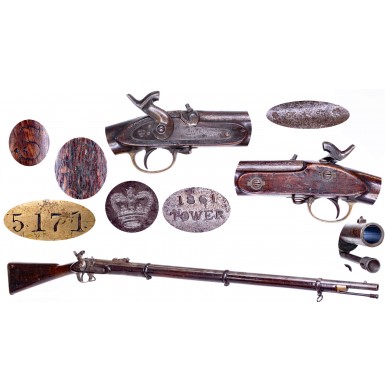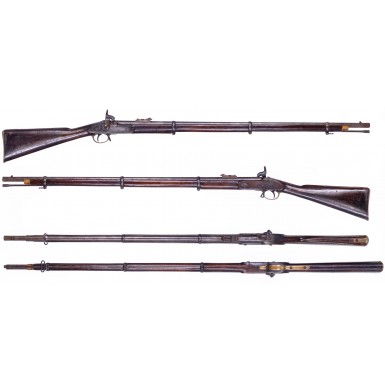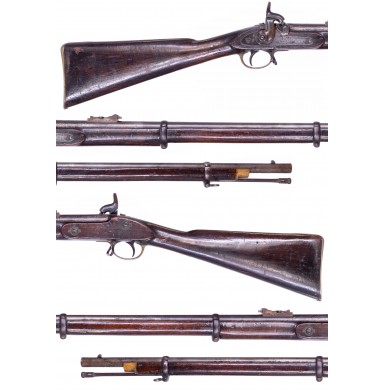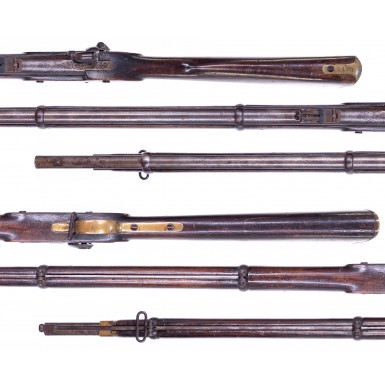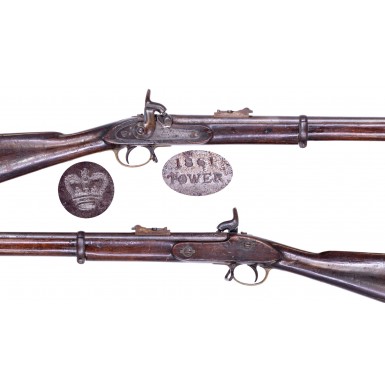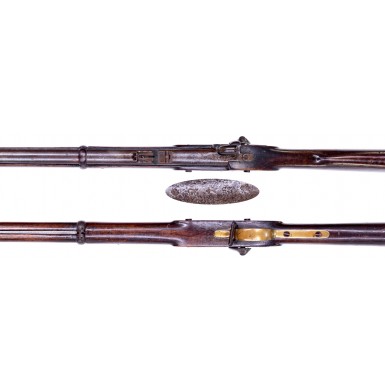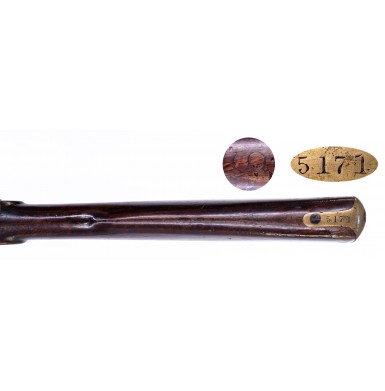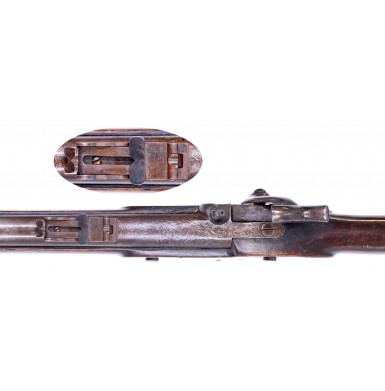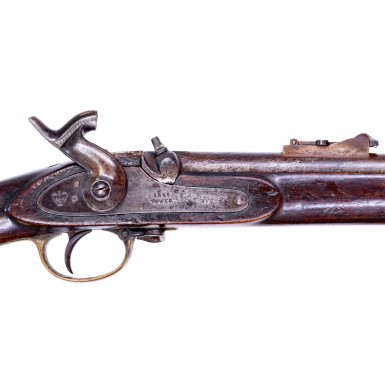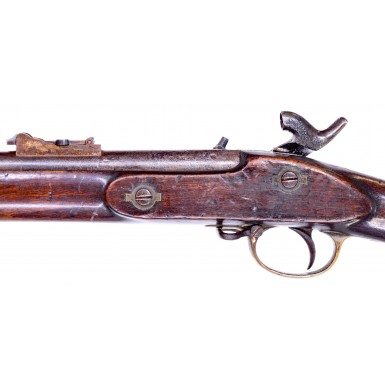Confederate Inspected and Inventory Numbered Enfield Rifle Musket
- Product Code: FLA-A324-SOLD
- Availability: Out Of Stock
-
$5,750.00
During the early days of the American Civil War, Confederate purchasing agents did a splendid job of tying up contracts for the British Pattern 1853 Enfield Rifle Musket, which was truly one of the most advanced and well-made military long arms of the day. According to Confederate Chief of Ordnance Josiah Gorgas’s 3 February 1863 summary of imported arms, some 70,980 “Long Enfield Rifles” were purchased from the beginning of the war through the end of 1862. These numbers only account for Confederate central government purchases, and do not include those Pattern 1853s purchased by the individual Confederate states or by speculators seeking to sell them within the Confederacy.
The majority of these arms were purchased from the firms of S. Isaac, Campbell & Company (who relied on John Edward Barnett & Sons to deliver many of those arms) or Sinclair, Hamilton & Company, who often routed their sales through S. Isaac, Campbell & Co as well. Additional Pattern 1853s were purchased from William Grazebrook of Liverpool, who made his first sales to Confederate purchasing agent Caleb Huse within 30 days of the opening of the war. Sinclair, Hamilton & Company entered into several contracts with the Confederacy to deliver Pattern 1853 Enfield Rifle Muskets, with the typical contract terms requiring 30,000 stands of arms to be delivered over a six-month period. During the course of the war, Sinclair, Hamilton & Company appears to have received at least five of these contracts for Pattern 1853 Enfield Rifle Muskets from the Confederate central government.
The second of these contracts for 30,000 Pattern 1853 “Long Enfields” is the one represented by the guns with the JS / {ANCHOR} viewer’s mark, along with the engraved buttplate tang inventory numbers. The initials “JS” stand for John Southgate, one of the primary English “viewers” (inspectors) hired by the Confederacy to inspect the arms purchased on contract from the English gunmakers. These inventory numbers ran from 1-10,000 in three series (to date no gun with a 10,000 number is known, although theoretically they existed). The first series had no suffix after the number, while the second series of 10,000 had an “A” suffix under the inventory number and the third series of 10,000 had a “B” suffix. These numbered guns represent the October 1861 contract with Sinclair, Hamilton & Company that is referred to in Confederate documents as the “Second Contract”. This contract required the 30,000 Enfields to be delivered between October of 1861 and April of 1862. At least two identified B-suffix guns with three-digit inventory numbers have been determined to have been issued in Corinth, MS immediately prior to the battle of Shiloh on April 6-7 of 1862. Thus, is it clear that the contract timeline for production and delivery was closely followed, and the Confederacy did a good job delivering arms through the Union blockade during the first year of the war.
Sinclair, Hamilton & Company acquired their arms through a series of sources referred to as the “Five Furnishers” in period documents. These were well-established gun making firms that were able to fill the large Sinclair, Hamilton & Company orders in a reasonable period of time, or at least arrange with additional contractors to make the deliveries needed. The “five furnishers” were the two multigenerational London gunmakers EP Bond, and Parker, Field & Sons, along with James Kerr. Kerr apparently received a tiny portion of the contract, only 500 of the 30,000 guns, due to his relationship with the London Armoury Company. Archibald Hamilton who was the principle of Sinclair, Hamilton & Company was also the managing director of The London Armoury Company. James Kerr of Kerr revolver fame, was London Armoury Company’s manager, having replaced his revolver designing rival Robert Adams in that position. The balance of the guns were delivered by the Birmingham based firms of C.W. James and W.C. Scott & Son.
The furnishers often marked the guns that were delivered under this contract with a large single letter on the upper comb of the stock, just forward of the buttplate tang. The guns were marked with a B for Bond, an F for Parker, Field & Sons, a J for C.W. James, a K for James Kerr, and an S for Scott & Son. A sixth single letter mark, P has been noted on a very few extant Confederate Enfields from this contract. This mark was previously thought to be an alternate mark for Parker, Field & Company. However, more recent examination of extant examples and the other associated marks on those guns has revealed that this was the mark of Francis Preston of Manchester, England. Preston’s relationship within the contracting circle of the “five furnishers” is not clear, but he delivered many socket bayonets for the numbered guns of this contract and may have received a small sub-contract to provide long arms as well. No period documents have shown that Preston delivered the guns directly to Sinclair, Hamilton & Company, so it is most likely that his guns were sub-contracted by James or Scott, who delivered the majority of the guns.
A 31 October 1861 dated letter from Sinclair, Hamilton & Co. notes that the contract was divided between the furnishers as follows: 8,000 guns from Scott & Son, 10,000 from CW James, 6,000 from E.P. Bond, 5,500 from Parker, Field & Sons and 500 from James Kerr. This indicates that the guns delivered by CW James, who was the largest supplier, represented about 33% of the total delivery under this contract. Scott & Sons delivered about 25% of the guns, Bond about 20% and Parker, Field & Sons about 18% of the guns. James Kerr’s deliveries represented less than 2% of all of the Second Contract rifle muskets. An extensive database comprised of more than two decades of collected information related to Confederate purchased Enfields contains approximately 300 numbered Pattern 1853 Enfield rifle muskets, not counting the numbered state purchased guns. Of those guns, the large majority are numbered guns with no suffix, which represent about 77% of the recorded samples. A-suffix guns represent about 16% of the recorded examples, while B-suffix guns represent about 7% of surviving examples that are recorded. To date, about 50 A-suffix and about 20 B-suffix Pattern 1853 Enfields are known to exist. The reason for the paucity of these arms is not clear, but it may simply be the result of attrition and the arms having been used up. With B-suffix guns, which would have theoretically been delivered later than the no suffix or “A” guns, the lack of extant examples may be an indication of the early successes experienced by the Union’s Atlantic Blockading Squadron.
Recorded numbers show a good distribution of engraved numbers from two digits through the mid 2XXX range. Then there is then a nearly 4,000 number gap in the database that seems to indicate that a large quantity of the “B-guns” in the 25XX to 62XX range may well be on the bottom of the Atlantic Ocean. “A suffix” guns, although uncommon and with few examples to study, show a nice even distribution through the entire numbering sequence. This suggests that their scarcity today is the result of them having seen hard use, rather than having been dumped overboard while a Confederate blockade runner tried to elude a pursuing US Naval vessel.
The Pattern 1853 Enfield Rifle Musket offered here is a classic example of a Confederate imported inventory numbered rifle musket that clearly saw use in the field. The gun is in about GOOD to NEAR VERY GOOD condition, especially for a Confederate purchased and used gun that was probably delivered no later than the first quarter of 1862. The gun retains well worn, but visible JS / {ANCHOR} inspection mark in the wood behind the trigger guard. While many Birmingham gunmakers would stamp their name along the toe line of the stock, this gun does not have such a maker’s mark. The top of the stock’s comb is stamped with a large S, indicating that Scott & Son were the furnisher who provided the gun to Sinclair, Hamilton & Company, but that does not mean that they were the actual maker. The buttplate of the gun is engraved with the Confederate inventory number 5171, placing it almost in the middle of the first group of 10,000 guns produced under this contract and well within the first 25% manufactured and delivered. The lock is marked in two lines, forward of the hammer, 1861 / TOWER, with the typical British Royal Crown mark to the rear of the hammer. The gun is a typical commercial one and bears no British military marks at all, which would be expected for guns bound for export markets. The upper left of the breech is marked with the usual post-1813 Birmingham commercial Provisional View, Definitive View, and Proof marks, with a pair of 25 gauge marks in between the other proofs, indicating the gun is .577 caliber. The marks are weak due the flash pitting around the breech of the gun. The interior of the lock is marked with a B&P over the mainspring and with the name S MARTIN around the mainspring boss stud. These markings give the first hint that the gun was not actually produced by Scott & Son, but rather by a sub-contractor working on their behalf. The name around the boss stud, when present, is the name of the lock’s maker. In this case it is likely the mark of Stephen Martin, a gun lock maker who worked in West Bromwich, Staffordshire during the 1850s and early 1860s. The initials “B&P” over the mainspring are the initials of the gun’s maker. Further investigation found the same initials under the barrel, confirming that. In this case, the mark almost certainly refers to the well-known and long-time Birmingham gunmaking firm of Bentley & Playfair. The company was a partnership between Joseph Bentley and Charles Playfair and was in operation from 1848-1900. The firm was located at 315-316 Summer Lane from 1860-1900. The top edge of the lock is marked with the file slash mating mark \ /. This same mating mark is found on the two other major components of the gun, on the bottom of the barrel and in the ramrod channel of the stock. The rear lock screw retains a weakly cut pair of matching file slash mating marks, but the front lock screw and the tang screw do not show a visible mating mark, and no mating marks are found on the barrel bands, but these marks are often so lightly cut on the rear edges of the bands that they are not visible after 150 years. The bottom of the barrel is marked with the name of the barrel maker, TURNER. Additionally, Thomas Turner’s TT initials are found here. As noted, the initials B&P for Bentley & Playfair are found under the barrel. As is typical of British-made Enfields, the bottom of the barrel is marked with a series of worker’s markings and other production marks, including the mating mark 60 on both the barrel and the breech plug, the number 462, and the initials JT. The number is probably a tracking number from Turner to allow him to correctly bill either Bentley & Playfair or possibly Scott & Son for the barrel and the “JT” initials are likely that of a workman, possibly the barrel’s finisher.
The barrel of the gun has a medium grayish brown mottled patina with scattered patches of light to moderate surface oxidation as well as areas of scattered surface roughness. The breech shows moderate amounts of flash pitting with lesser amounts of scattered light pitting present along its length. The barrel has been professionally relined and this can only be revealed by careful inspection of the muzzle and by the fact that the bore of the gun is in EXCELLENT condition. The bore is brilliant and retains excellent three-groove rifling. The barrel bands have a nice, untouched plum brown patina, and all match each other very well and the barrel of the gun very well. All three of the barrel band screws retain the “doughnut” shaped keepers on their end, which are usually missing. All of these keepers appear to be original to the musket. The gun retains what appears to be its original sling swivels on both the upper barrel band and on the bow of the trigger guard. The ramrod spoon has been removed from the stock, something that may well have occurred during the period of use to allow the ramrod to be more easily withdrawn from the gun in combat. The action of the gun is in very good mechanical condition and functions as it should. The lock has the same mottled gray and brown patina as the rest of the gun, with some darker mottling, suggesting minor traces of the original case colored finish. The lock markings are crisp and fully legible, although the lock does show some very lightly scattered pin pricking and oxidized crust on its surface. The brass furniture has a nice, untouched, medium golden patina, which is very attractive. As noted, the Confederate inventory number 5171 is neatly engraved on the tang, and the furnisher letter S is neatly stamped in the wood forward of the tang. The original long-range rear sight is in place and is complete and fully functional. The original combination musket front sight and socket bayonet lug is present near the muzzle of the musket. The original ramrod, which was numbered to the gun, is missing in action. This is typical with numbered Enfields, as less than 10% of extant examples retain a numbered ramrod, let alone the original matching one. The ramrod that now accompanies the gun is an original, period rod of Pattern 1853 pattern and has a deep brown patina that matches the balance of the gun well. It is full-length with threads at the end. The rod is fairly thick and fits in the ramrod channel tightly, which may be why the spoon was removed from the stock. Thousands of replacement Enfield ramrods were imported thought the Confederate port of Wilmington, NC between 1863 and 1864, suggesting the breakage and loss of rammers in the field was a constant and ongoing problem. The stock is in about VERY GOOD condition overall. The stock is solid, complete, and full-length, with no breaks, significant cracks or repairs noted. The stock shows moderate to heavy wear from use in the field, and even though the sharp edges of the counterpane show rounding, it does not appear to have been sanded in the modern era. Due to the heavy wear and use the stock shows numerous scattered bumps, dings, rubs and mars. This is the wear that one would be expect to find on a 150+ year-old Confederate military arm. The stock also shows a few minor splinters out of the rammer channel and some moderate amounts of wood loss due to burn out behind the bolster. As noted previously, the stock well-worn JS / {ANCHOR} inspection stamp in the wood behind the trigger guard, which is light due to the fact that the wrist of the gun is handled more than any other part of a musket in the field.
Overall, this a completely authentic, if well-worn and heavily used example of a Confederate inspected and inventory numbered Pattern 1853 Enfield Rifle Musket. The gun was delivered by Scott & Son, the second most prolific of the Five Furnishers who delivered Enfields under the 2nd Sinclair, Hamilton & Company contract. The gun has the requisite JS / {ANCHOR} inspection behind the triggerguard, along with a nice furnisher’s mark and fine engraved inventory number on the buttplate. This gun was clearly a very early arrival in the Confederacy that was likely on the field well before the beginning of the 1862 spring and summer campaign seasons. Only about 1% of the 30,000 guns from the 2nd Sinclair, Hamilton & Company contract are known to have survived to be in collections today, and this is one of those incredibly scarce extant Confederate purchased guns. If you have ever wanted to own a completely honest example of a Confederate purchased, marked, and used Pattern 1853 Enfield Rifle Musket, that really saw service and fought the war, this would be a good addition to your collection. This is an authentic, honest, and fairly priced example that would be a solid addition to any collection of Civil War or Confederate long arms.
SOLD
Tags: Confederate, Inspected, and, Inventory, Numbered, Enfield, Rifle, Musket

